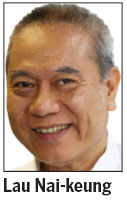'Population issue' or bureaucrat-speak?
Updated: 2013-10-29 06:50
By Lau Nai-keung(HK Edition)
|
|||||||||
The government launched a four-month consultation on population policy last week to elicit views on our "population challenges" and how to deal with them. "Our population is aging and aging fast," the consultation document reads. "According to projections, our labor force will start declining from 2018."
At a media briefing to announce the consultation, Chief Secretary Carrie Lam Cheng Yuet-ngor, also Steering Committee on Population Policy chairperson, said nearly one in every three people in the city will be 65 or older by 2041.
An aging population will raise the dependency ratio, slow down the pace of economic growth, and lead to increased public expenditure. We will have to tackle these issues, and society must have a lively discussion so that we can reach a compromise on a number of contentious issues. However, this will not happen because the consultation paper framed the problems inappropriately.
First of all, the steering committee should be open-minded. The so-called "population challenges" are manifestations of Hong Kong's deep-rooted contradictions. As the world's economy changed, Hong Kong developed from an entrepot to a manufacturing center and now to a financial center. To a certain extent, these transformations were reactionary, but there were also substantive conscious efforts on the part of the government to promote and facilitate them.
Take garment manufacturing as an example. "Free trade" in Hong Kong was possible not only because we agreed to voluntarily restrain exports, but also through the excellent work of the Department of Commerce, together with input from the garment and textile industry, which enabled the city to navigate the difficult waters of the General Agreement on Tariffs and Trade (GATT) and the Multi-Fibre Agreement (the latter now expired). Is our government still ready to lead the changes proactively?

In order to encourage young couples to have children, Lam's steering committee has considered ideas from a baby bonus to longer paid maternity leave, flexible working hours, more subsidized child care and after-school care services. Tongue in cheek, Lam was quick to reject them, even before the start of the consultation, as "they may not be feasible because of the low tax regime".
"In a society with a low tax rate, we need to stick to the principle of managing public finances prudently and we need to seriously consider whether it is effective to encourage couples giving birth by providing cash allowances and tax deductions," Lam said.
Tax rate serves the society, not vice versa. We rethink our population policy to create a society that is inclusive and sustainable, not to maintain one with a low tax rate.
The second problem with the consultation is that it poses questions that are unsolvable under the prevailing paradigm. On the bright side, it is encouraging to see our chief secretary acknowledges "skills mismatch and the lack of job diversity are growing concerns. Employers of certain industries have complained about not being able to recruit enough workers to fill vacancies. But simultaneously some young people feel their path to upward mobility is being blocked by a lack of quality jobs." However, it is unclear how these long-standing issues can be properly dealt with short of an industrial policy.
To a certain extent, Lam realizes that she is compartmentalizing things. In typical bureaucrat-speak, her justification is that the committee chose not to duplicate subjects currently studied by other institutions so as to "give our public engagement exercise a better focus". This approach will make the report much less meaningful, only a lot easier to draft.
The third problem with the consultation is its shortsightedness. The world is changing rapidly, so is technology, production and work. It is beyond doubt that the world in 2041 will be vastly different from today's, but some trends are already emerging. Things that were not imaginable a few years back, such as 3-D printing and enhanced automation enabled by machine-to-machine communication, are quickly becoming the new reality. What is the role of people (the population/labor force) in the new equation?
In the consultation paper foreword, Lam informed us that the labor force participation rate will drop from 58.8 percent in 2012 to 49.5 percent in 2041, and causally asked: "Can our economy stay competitive with fewer workers?"
She thought the question was rhetorical, but it is more likely than not that the answer is, "Yes, it probably can". The question that should follow then becomes: What does it mean for the rest of us who are not needed as producers?
The author is a member of the Commission on Strategic Development.
(HK Edition 10/29/2013 page9)